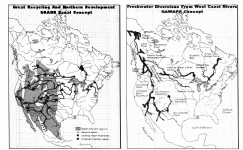Davka
Senior Member
If we can build a pipeline to bring oil from Alaska to the Gulf of Mexico, this should be a breeze: Build a water pipeline connecting the upper Mississippi with the Colorado.
Of course, there would need to be some tweaks. For one, no biological material could be allowed to flow from one river to the other. For another, a series of artificial reservoirs would been to be built alongside the Colorado (not dams - reservoirs) to manage seasonal and yearly variations in flow. Dredging might be needed to keep the Mississippi navigable.
But the upside would be incredible. Crop yields up the wazoo. Potential floods of the Mississippi could be ameliorated by increasing the transfer volume. Some of the water could even be diverted to farms on the Great Plains, during drought years.
The Mississippi drains close to half of the landmass of the USA. We should be managing this water far more effectively, instead of simply allowing it to pour into the sea.
Of course, there would need to be some tweaks. For one, no biological material could be allowed to flow from one river to the other. For another, a series of artificial reservoirs would been to be built alongside the Colorado (not dams - reservoirs) to manage seasonal and yearly variations in flow. Dredging might be needed to keep the Mississippi navigable.
But the upside would be incredible. Crop yields up the wazoo. Potential floods of the Mississippi could be ameliorated by increasing the transfer volume. Some of the water could even be diverted to farms on the Great Plains, during drought years.
The Mississippi drains close to half of the landmass of the USA. We should be managing this water far more effectively, instead of simply allowing it to pour into the sea.

